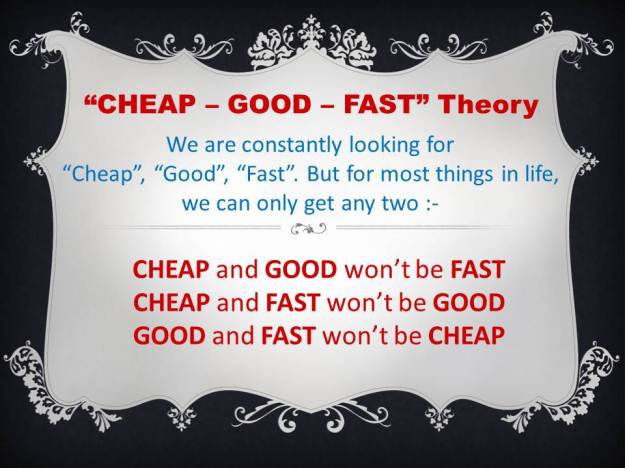
A good friend of mine shares an interesting theory about “cheap”, “good”, “fast”. According to him, dissatisfaction in life is caused by our pursuant for “cheap”, “good”, “fast” all at once but in most cases, we can only fulfil 2 out of these 3 criteria at any single time. We can find many of these examples in our life and it is understandably very frustrating. Take for example:-
- We might able to get “cheap” bargain, “good” product but might take times to find this type of deal (not fast).
- Or we can find “good” products and can get it up and running “fast”, but might cost us some money (not cheap).
- Or we might able to get “cheap” bargain and available immediately (fast) but turn out it is a substandard product (not good).
While we should constantly pursuing perfection in life, however focusing too much on finding all these three elements is countered productive and will distracting us from solving the fundamental problem – either to reduce our cost (if you are a cost centre) or increase our revenue (if you are a profit centre).
If you are entrusted your company to find solution to reduce current operation cost or increase revenue, I reckon finding something “good” and in shortest time (fast) is your top priority because every moment of delay means the company is incurring more operation cost or earning lesser revenue. This is especially true if the saving or profit from the new solution can be substantially larger than the cost of acquiring the new solutions. In other word, we should evaluate the cost of the new solutions by taking into consideration what is the potential saving or extra revenue it might generate, rather than merely looking at its face value. In other word, a product that cost you more can become a more viable and cheaper solution, because the saving or extra revenue it generates will outweight its acquisition cost.
In contrary, a cheaper product that doesn’t save you a penny or bring in any extra dollar is considered more expensive in this equation. Hence, our noble intention of looking for cheaper solution need to include all cost parameters into equation instead of focusing on single cost factor – product acquisition cost.
For apple to apple comparison, the cost factors need to include software licenses, development, documentation (system manual, training material), training, maintenance, help desk support, R&D for continuous upgrade & improvement, potential lost in saving, potential revenue lost, as well as cost related to deployment risk (the higher the risk, you might want to factor in higher cost), etc.
After you have figured out all the cost factors, then you will realize cheap or expensive is indeed relatively subjective in this case if you are not comparing apple to apple. Hence value is a better indicator than cost of the product (cheap or expensive) in our quest for solution that can help reduce our operating cost or increase our profitability.

